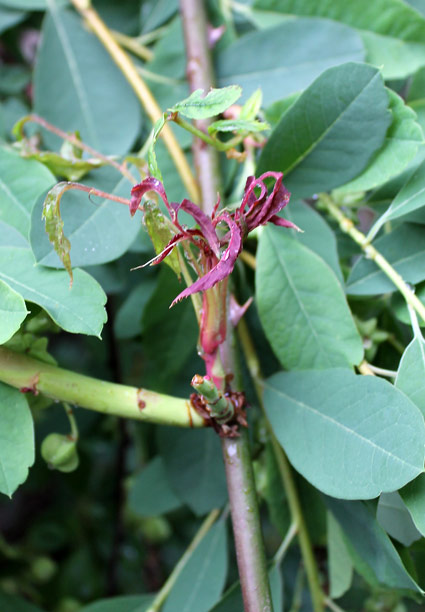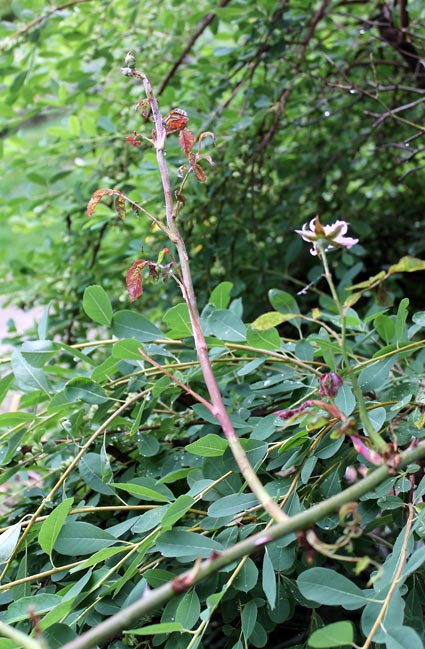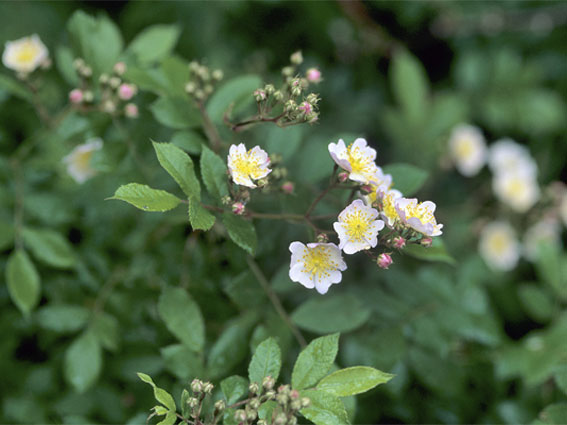Why Don’t My Shrubs Bloom?
Don't lose heart if your shrubs have stopped flowering - here's help to bring the blooms back.

The telltale sign of rose rosette disease is an excess of reddish-purple and distorted new growth. © George Weigel
As if roses didn’t already have enough bugs and diseases threatening them, another new – and deadly – virus is rearing its head throughout much of the United States. It is called Rose rosette disease. It can infect and kill almost all types of roses, including the popular and heretofore bullet-proof ‘Knock Out’ varieties. The virus is spread by a tiny mite (Phyllocoptes fructiphilus) that can travel upwards of 100 miles on wind currents, rain, and snowflakes.
The virus-carrying mites survive most winters and reproduce at breakneck speed – cranking out new generations every 7 to 10 days when temperatures are 60 degrees and above. They cause host roses to show symptoms within weeks to months, although an infected plant may struggle for several years before it finally dies. Entomologists say that once an infection is noticed, it’s usually ingrained enough that the plant is doomed. The recommendation at that point: remove the plant, and bag it or burn it. DO NOT COMPOST.
Rosarians and rose hobbyists who have seen the disease say it seems to strike gardens randomly, infecting a few here and a few there each year as opposed to swooping in and wiping a whole rose garden at once. Both the mite and the virus apparently are Rocky Mountain natives that first attacked the species Rosawoodsii in the 1940s. But it was only in 2011 when the virus was identified. Rose rosette disease has been steadily moving eastward, and now has been found throughout the Midwest and East Coast.

An early sign of possible rose rosette infection is the appearance of many upward stems, especially with distorted new leaves on them. © George Weigel
There is no cure. The usual first sign of trouble is shoots that grow straight up. The typical telltale symptom, though, is when roses put out excess branch clusters with new leaves that are small, contorted and typically reddish-purple. In other words, the plants have a lot of distorted, discolored new growth. Infected roses also often produce excessive thorns that are more pliable than usual. The disease may lead to less flowering or to flowers with discolored or misshapen petals.
Entomologists say the best way to protect healthy roses is to spray against the mite that spreads the disease. That’s a tall order, though, since new generations of mites keep coming every 7 to 10 days, weekly sprays are needed from early spring through late fall.
General insecticides designed to control Japanese beetles, aphids, and other rose-attacking bugs may not do the trick. Carbaryl and bifenthrin are two that a Virginia Tech University bulletin says are reasonably effective. Specific mite-killing products (i.e. “miticides” or horticultural oil) are the most effective controls. Look for ones that list eriophyid mites on the label.

The invasive multiflora rose is a favorite host plant of the mites that cause rose rosette disease. © Bill Johnson
Beyond that, eradicating surrounding populations of wild multiflora rose might help. This is the gangly, white to light-pink rose that was originally introduced as a rose-breeding rootstock and a soil-erosion control during the 1930s, 1940s and 1950s. However, the multiflora rose turned out to be so vigorous and such a rampant seeder that it’s now on some states’ invasive-plant lists.
In the case of rose rosette disease, the multiflora rose seems to be its favorite host. It’s also highly susceptible to the disease and readily killed by it. On the one hand, that’s good news because nature is beginning to control a plant that’s turned weedy. On the other, it’s bad news because the wealth of multiflora rose is speeding the spread of the disease. When mite-infested multifloras are anywhere nearby (and “nearby” can mean 100 miles), it’s not a problem for the mites to jump to landscape roses. The closer the infected multifloras, the more likely the spread.
Rosarians say it’s possible to save rose bushes if infected canes are noticed early and removed the whole way down to the crown. Valuable or sentimental plants also can be salvaged by pruning still-healthy shoots and tips, and either grafting them to a new rootstock or sticking them in a potting medium to create new rooted tips. Then when the mother plant dies, at least progeny may live on.
Before yanking a suspicious rose, get an accurate diagnosis from an expert, such as a state agriculture department, a university plant pathologist or an Extension office. Rose rosette symptoms can be confused with benign mutations, weather injuries and herbicide reactions that wouldn’t warrant removal.
The disease isn’t soil-borne, so a new rose can be planted in spots where rose rosette disease has wiped out other ones, although it is not recommended. However, since the disease-causing mites are in the area, it’s possible – and maybe even likely – that they’ll infect the new roses. Some new evidence also suggests that the disease may spread from rose-root to rose-root, meaning that if you don’t dig out all of an infected rose’s roots, those could infect both new or neighboring roses.
The disease does not spread to or infect any other plant species. Both the mite and the virus are specific to roses. Breeders already are at work trying to come up with new cultivars that resist rose rosette disease. Although the disease infects a majority of roses on the market today, several kinds apparently resist infection, including Rosa bracteata, R. arkansana, R. blanda, R. palustris and R. setigera. Researchers also are beginning to look at natural, biological controls that might control the mite, including a type of thrips that can devour one mite every few seconds.